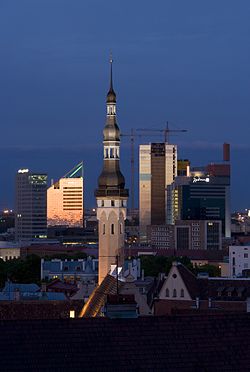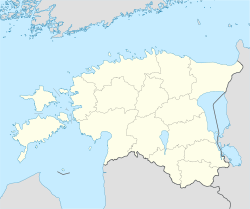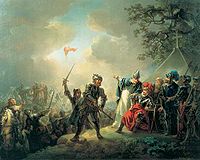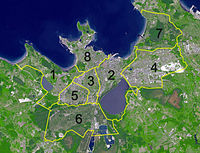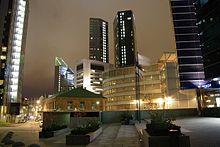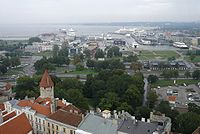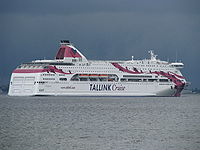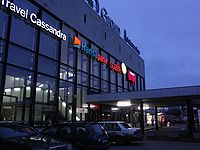- Tallinn
-
Tallinn High rise buildings looking over the Old Town 
Flag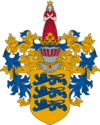
Coat of armsCoordinates: 59°26′14″N 24°44′43″E / 59.43722°N 24.74528°ECoordinates: 59°26′14″N 24°44′43″E / 59.43722°N 24.74528°E Country  Estonia
EstoniaCounty  Harju County
Harju CountyFirst appeared on map 1154 Town rights 1248 Government – Mayor Edgar Savisaar (Centre Party) Area – Total 159.2 km2 (61.5 sq mi) Population (Oct 1, 2011[1]) – Total 414,940 – Density 2,587.8/km2 (6,492.8/sq mi) Time zone EET (UTC+2) – Summer (DST) EEST (UTC+3) Website www.tallinn.ee Tallinn /ˈtælɪn/ is the capital and largest city of Estonia. It occupies an area of 159.2 km2 (61.5 sq mi) with a population of 414,940.[1] It is situated on the northern coast of the country, on the banks of the Gulf of Finland, 80 km (50 mi) south of Helsinki, east of Stockholm and west of Saint Petersburg. Tallinn's Old Town is in the list of UNESCO World Heritage Sites. It is ranked as a global city and has been listed among the top 10 digital cities in the world.[2] The city is a European Capital of Culture for 2011, along with Turku, Finland.
Contents
Toponymy
Historical names
In 1154 a town called Qlwn[3] or Qalaven (possible derivations of Kalevan or Kolyvan)[4][5] was put on the world map of the Almoravid by cartographer Muhammad al-Idrisi who described it as a small town like a large castle among the towns of Astlanda. It has been suggested that the Quwri in Astlanda may have denoted the predecessor town of today's Tallinn.[6][7]
The earliest names of Tallinn include Kolyvan (Russian: Колывань) known from East Slavic chronicles, the name possibly deriving from the Estonian mythical hero Kalev.[8][9]
Up to the 13th century the Scandinavians and Henry of Livonia in his chronicle called the town Lindanisa: Lyndanisse in Danish,[10][11][12] Lindanäs in Swedish, also mentioned as Ledenets in Old East Slavic. According to some theories the name derived from mythical Linda, the wife of Kalev and the mother of Kalevipoeg.[13] who in an Estonian legend carried rocks to her husband's grave that formed the Toompea hill.[14]
It has been also suggested that in the context the meaning of linda in the archaic Estonian language, that is similar to lidna in Votic, had the same meaning as linna or linn later on meaning a castle or town in English. According to the suggestion nisa would have had the same meaning as niemi (meaning peninsula in English) in an old Finnish form of the name Kesoniemi.[15]
Other than Kesoniemi known ancient historical names of Tallinn in Finnish include Rääveli. The Icelandic Njálssaga mentions Tallinn and calls it Rafala, which is a variant of the name Raphael.
After the Danish conquest in 1219 the town became known in the German, Swedish and Danish languages as Reval (Latin: Revalia). The name originated from (Latin) Revelia (Estonian) Revala or Rävala, the adjacent ancient name of the surrounding Estonian county.
Modern name
The origin of the name "Tallinn(a)" is certain to be Estonian, although the original meaning of the name is debated. It is usually thought to be derived from "Taani-linn(a)" (meaning "Danish-castle/town"; Latin: Castrum Danorum) after the Danes built the castle in place of the Estonian stronghold at Lindanisse. However, it could also have come from "tali-linna" ("winter-castle/town"), or "talu-linna" ("house/farmstead-castle/town"). The element -linna, like Germanic -burg and Slavic -grad / -gorod, originally meant "fortress" but is used as a suffix in the formation of town names.
The previously used official German name
 Reval (help·info) (Ревель) was replaced after Estonia became independent in 1918–1920. At first both forms Tallinna and Tallinn were used.[16] The United States Board on Geographic Names adopted the form Tallinn between June 1923 and June 1927.[17] The form Tallinna appearing in modern times in Estonian denotes the genitive case of the name, as in Tallinna Reisisadam (Port of Tallinn).
Reval (help·info) (Ревель) was replaced after Estonia became independent in 1918–1920. At first both forms Tallinna and Tallinn were used.[16] The United States Board on Geographic Names adopted the form Tallinn between June 1923 and June 1927.[17] The form Tallinna appearing in modern times in Estonian denotes the genitive case of the name, as in Tallinna Reisisadam (Port of Tallinn).Other variations of modern spellings include Tallinna in Finnish and Та́ллин in Russian.
A form Tallin deriving from the Romanization of Russian spelling of the name Та́ллин [18] was also used internationally during the era Estonia was annexed to the Soviet Union.
History
Historic Centre (Old Town) of Tallinn * UNESCO World Heritage Site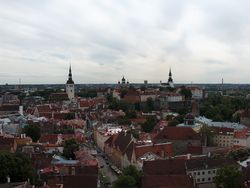
Country Estonia Type Cultural Criteria ii, iv Reference 822bis Region ** Europe and North America Inscription history Inscription 1997 (21st Session) * Name as inscribed on World Heritage List
** Region as classified by UNESCO The original Old Thomas (1530)
The original Old Thomas (1530)
The first traces of human settlement found in Tallinn's city center by archeologists are about 5000 years old. The comb ceramic pottery found on the site dates to about 3000 BC and corded ware pottery c. 2500 BC.[19]In 1050 the first fortress was built on Tallinn Toompea.[4]
As an important port for trade between Russia and Scandinavia, it became a target for the expansion of the Teutonic Knights and the Kingdom of Denmark during the period of Northern Crusades in the beginning of the 13th century when Christianity was forcibly imposed on the local population. Danish rule of Tallinn and Northern Estonia started in 1219.
In 1285 the city became the northernmost member of the Hanseatic League – a mercantile and military alliance of German-dominated cities in Northern Europe. The Danes sold Tallinn along with their other land possessions in northern Estonia to the Teutonic Knights in 1346. Medieval Tallinn enjoyed a strategic position at the crossroads of trade between Western and Northern Europe and Russia. The city, with a population of 8,000, was very well fortified with city walls and 66 defence towers.
A weather vane, the figure of an old warrior called Old Thomas, was put on top of the spire of the Tallinn's Town Hall in 1530 that became the symbol for the city.
With the start of the Protestant Reformation the German influence became even stronger as the city was converted to Lutheranism. In 1561 Tallinn politically became a dominion of Sweden.
During the Great Northern War, Tallinn along with Swedish Estonia and Livonia capitulated to Imperial Russia in 1710, but the local self-government institutions (Magistracy of Reval and Chivalry of Estonia) retained their cultural and economical autonomy within Imperial Russia as the Duchy of Estonia. The Magistracy of Reval was abolished in 1889. The 19th century brought industrialization of the city and the port kept its importance. During the last decades of the century Russification measures became stronger.
On 24 February 1918, the Independence Manifesto was proclaimed in Tallinn, followed by Imperial German occupation and a war of independence with Russia. On 2 February 1920, the Tartu Peace Treaty was signed with Soviet Russia, wherein Russia acknowledged the independence of the Estonian Republic. Tallinn became the capital of an independent Estonia. After World War II started, Estonia was occupied by the Soviet Union (USSR) in 1940, and later occupied by Nazi Germany from 1941 to 44. After the Nazi retreat in 1944, it was again occupied by the USSR. After annexation into the Soviet Union, Tallinn became the capital of the Estonian SSR.
During the 1980 Summer Olympics, the sailing (then known as yachting) events were held at Pirita, north-east of central Tallinn. Many buildings, such as the "Olümpia" hotel, the new Main Post Office building, and the Regatta Center, were built for the Olympics.
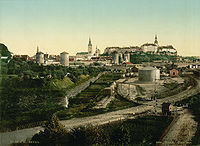 Tallinn on an 1890s photochrom
Tallinn on an 1890s photochrom
In August 1991 an independent democratic Estonian state was re-established and a period of quick development to a modern European capital ensued. Tallinn became the capital of a de facto independent country once again on August 20, 1991.
Tallinn has historically consisted of three parts:
- The Toompea (Domberg) or "Cathedral Hill", which was the seat of the central authority: first the Danish captains, then the komturs of the Teutonic Order, and Swedish and Russian governors. It was until 1877 a separate town (Dom zu Reval), the residence of the aristocracy; it is today the seat of the Estonian government and many embassies and residencies.
- The Old Town, which is the old Hanseatic town, the "city of the citizens", was not administratively united with Cathedral Hill until the late 19th century. It was the centre of the medieval trade on which it grew prosperous.
- The Estonian town forms a crescent to the south of the Old Town, where the Estonians came to settle. It was not until the mid-19th century that ethnic Estonians replaced the local Baltic Germans as the majority amongst the residents of Tallinn.
Historically, the city has been attacked, sacked, razed and pillaged on numerous occasions. Although extensively bombed by Soviet air forces during the latter stages of World War II, much of the medieval Old Town still retains its charm. The Tallinn Old Town (including Toompea) became a UNESCO World Cultural Heritage site in 1997.
At the end of the 15th century a new 159 m (521.65 ft) high Gothic spire was built for St. Olaf's Church. Between 1549 and 1625 it was the tallest church in the world. After several fires and following rebuilding, its overall height is now 123 m (403.54 ft).
Geography
Tallinn is situated on the southern coast of the Gulf of Finland, in north-western Estonia.
The largest lake in Tallinn is Lake Ülemiste (covering 9.6 km²). It is the main source of the city's drinking water. Lake Harku is the second largest lake within the borders of Tallinn and its area is 1.6 km². Tallinn does not lie on a major river. The only significant river in Tallinn is Pirita River in Pirita, a city district counted as a suburb. Historically, the small Härjapea River flowed from Lake Ülemiste through the town into the sea, but the river was diverted for sewage in the 1930s and has since completely disappeared from the cityscape.
A limestone cliff runs through the city. It can be seen at Toompea, Lasnamäe and Astangu. However, Toompea is not a part of the cliff, but a separate hill.
The highest point in Tallinn, at 64 meters above sea level, is situated in Hiiu, Nõmme District, in the south-west of the city.
The length of the coastline is 46 kilometres. It comprises three bigger peninsulas: Kopli peninsula, Paljassaare peninsula and Kakumäe peninsula.
Climate data for Tallinn Month Jan Feb Mar Apr May Jun Jul Aug Sep Oct Nov Dec Year Record high °C (°F) 9.2
(48.6)10.2
(50.4)15.9
(60.6)27.2
(81.0)29.7
(85.5)31.2
(88.2)32.3
(90.1)31.2
(88.2)28.5
(83.3)21.8
(71.2)13.4
(56.1)10.7
(51.3)32.3
(90.1)Average high °C (°F) −2.9
(26.8)−3
(27)0.8
(33.4)7.3
(45.1)14.0
(57.2)18.8
(65.8)20.8
(69.4)19.9
(67.8)14.9
(58.8)9.0
(48.2)3.3
(37.9)−0.2
(31.6)8.6 Average low °C (°F) −8.2
(17.2)−8
(18)−5.6
(21.9)−0.2
(31.6)4.9
(40.8)9.9
(49.8)12.5
(54.5)12.0
(53.6)8.0
(46.4)3.7
(38.7)−0.9
(30.4)−4.9
(23.2)1.9 Record low °C (°F) −31.4
(−24.5)−31
(−24)−26.2
(−15.2)−17.2
(1.0)−4.3
(24.3)0.0
(32.0)4.4
(39.9)1.7
(35.1)−4.7
(23.5)−10.5
(13.1)−21.3
(−6.3)−32.2
(−26.0)−32.2
(−26.0)Precipitation mm (inches) 45
(1.77)29
(1.14)29
(1.14)36
(1.42)37
(1.46)53
(2.09)79
(3.11)84
(3.31)82
(3.23)70
(2.76)68
(2.68)55
(2.17)667
(26.26)Source: Pogoda.ru.net[20] Administrative districts
District Area Population 1. Haabersti 18.6 km² 35,000 2. Kesklinn (centre) 28.0 km² 34,985 3. Kristiine 9.4 km² 27,531 4. Lasnamäe 30.0 km² 108,644 5. Mustamäe 8.0 km² 62,219 6. Nõmme 28.0 km² 35,043 7. Pirita 18.7 km² 8,507 8. Põhja-Tallinn 17.3 km² 52,573 For local government purposes, Tallinn is subdivided into 8 administrative districts (Estonian: linnaosad, singular linnaosa). The district governments are city institutions that fulfill, in the territory of their district, the functions assigned to them by Tallinn legislation and statutes.
Each district government is managed by an Elder (Estonian: linnaosavanem). He or she is appointed by the City Government on the nomination of the Mayor and after having heard the opinion of the Administrative Councils. The function of the Administrative Councils is to recommend, to the City Government and Commissions of the City Council, how the districts should be administered.
Population
Ethnic composition (2009)[21] Nationality Percentage Estonians 52.2% Russians 38.6% Ukrainians 3.8% Belarusians 2.1% Finns 0.6% Others 2.7% The registered population of Tallinn is 414,940 (as of 1 Nov 2011).[1]
According to Eurostat, in 2004 Tallinn had the largest number of non-EU nationals of all EU member states' capital cities.[22] As of 2009 around 22% of its population are not EU citizens.[21]
In addition to the native Estonian language (which is of the Finnic group, closely related to the Finnish language), English, Finnish and Russian are widely understood in Tallinn. Russian is also widely spoken as a native language.
Population development Year 1372 1772 1816 1834 1851 1881 1897 1925 1959 1989 1996 2000 2005 2006 2007 2011 Population 3,250 6,954 12,000 15,300 24,000 45,900 58,800 119,800 283,071 478,974 427,500 400,378 401,694 399,108 400,911 412,144 Economy
In addition to longtime functions as seaport and capital city, Tallinn has seen development of an information technology sector; in its 13 December 2005, edition, The New York Times characterized Estonia as "a sort of Silicon Valley on the Baltic Sea".[23] One of Tallinn's sister cities is the Silicon Valley town of Los Gatos, California. Skype is one of the best-known of several Estonian start-ups originating from Tallinn. Many start-ups started from the Soviet-era Institute of Cybernetics. The economic sectors of Tallinn also include the light, textile, and food industry, as well as the service and government sector. There is a small fleet of ocean going-trawlers that operate out of Tallinn.[24] Port of Tallinn is one of the biggest ports in the Baltic sea region.[25]
Currently, over half of the Estonian GDP is created in Tallinn.[26] In 2008, the GDP per capita of Tallinn stood at 172% of the Estonian average.[27] This makes the GDP of Tallinn be at 115% of the European Union average, while the overall GDP level of Estonia is at 67% of the EU average.
Notable headquarters
Among others:
- NATO Cooperative Cyber Defence Centre of Excellence (CCDCOE)
- Estonian Air has its headquarters in Tallinn.[28]
- Skype has its software development centre located in Tallinn[29]
- Ericsson has one of its biggest production facilities in Europe located in Tallinn, focusing on the producing of 4G communication devices.[30]
- Statoil has announced moving the group's financial centre to Tallinn.[31]
Education
Institutions of higher education and science include:
- Tallinn University
- Tallinn University of Technology
- Estonian Business School
- Estonian Academy of Music and Theatre
- Estonian Academy of Arts
- Public Service Academy
- Estonian Evangelical Lutheran Church Institute of Theology
Tourism
 St. Olaf's church was the tallest building in the world from 1549 to 1625
St. Olaf's church was the tallest building in the world from 1549 to 1625
Since its return to independence, improving air and sea transport links with Western Europe and Estonia's accession to the European Union have made Tallinn easily accessible to tourists.
Estonia has made rapid economic progress since independence and this is reflected in local prices.[32] Although not extortionate, neither are prices as cheap as in other former Eastern Bloc countries.
The main attractions are in the two old towns (Lower Town and Toompea) which are both easily explored on foot. Eastern districts around Pirita and Kadriorg are also worth visiting and the Estonian Open Air Museum (Eesti Vabaõhumuuseum) in Rocca al Mare, west of the city, preserves aspects of Estonian rural culture and architecture.
Toompea – Upper Town
This area was once a separate town (Dom zu Reval), the residence of the Chivalry of Estonia, Roman Catholic bishops of Tallinn (until 1561) and Lutheran superintendents of Estonia, occupying an easily defensible site overlooking the surrounding districts. The major attractions are the walls and various bastions of Castrum Danorum, the Russian Orthodox Alexander Nevsky Cathedral (built during the period of Russian Empire, the church was built on a site that formerly housed a statue of Martin Luther) and the Lutheran Cathedral (Toomkirik) and the old Estonian Royal Palace now the Parliament building.
All-linn – Lower Town
This area is one of the best preserved old towns in Europe and the authorities are continuing its rehabilitation. Major sights include Raekoja plats (Town Hall square), the town walls and towers (notably "Fat Margaret" and "Kiek in de Kök") and St Olaf church tower (124 m).
Kadriorg
This is 2 kilometres east of the centre and is served by buses and trams. Kadriorg Palace, the former palace of Peter the Great, built just after the Great Northern War, now houses (part of) the Art Museum of Estonia, presidential residence and the surrounding grounds include formal gardens and woodland. Restored 2001–2004 with a large donation from the Swedish Government
The new residence of the Art Museum of Estonia: KUMU (Kunstimuuseum, Art Museum) was built several years ago.
Pirita
This coastal district is a further 2 kilometres north-east of Kadriorg. The marina was built for the Moscow Olympics of 1980, and boats can be hired on the Pirita River. Two kilometres inland are the Botanic Gardens and the Tallinn television tower.
-
Alexander Nevsky Cathedral built in 1894–1900.
Transport
 An Estonian Air plane in Tallinn Airport
An Estonian Air plane in Tallinn Airport
City transport
Main article: Public transport in TallinnThe city operates a system of bus (62 lines), tram (4 lines) and trolley-bus (8 lines) routes to all districts. A flat-fare system is used. Payment for single tickets is made either by pre-purchase of tickets at street-side kiosks or by a purchase from the transport vehicle. Monthly cards are available by registering through the national ID-card.
Air
The Lennart Meri Tallinn Airport is about four kilometres from Town Hall square (Raekoja plats). There is a local bus connection between the airport and the edge of the city centre (bus no. 2). The nearest railway station Ülemiste is only 1.5 km from the airport.
The construction of the new section of the airport began in 2007 and was finished in summer 2008.
There has been a helicopter service to and from Helsinki operated by Copterline and taking 18 minutes to cross the Gulf of Finland. The Copterline Tallinn terminal is located adjacent to Linnahall, five minutes from the city center. After a crash near Tallinn in August 2005, service was suspended but restarted in 2008 with a new fleet.[33] The operator cancelled it again in December 2008,[34] on grounds of unprofitability. On 15 February 2010, Copterline filed for bankruptcy, citing inability to keep the company profitable.
Ferry
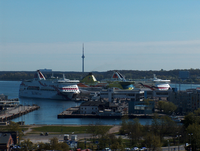 Tallink's ferries and TV Tower
Tallink's ferries and TV Tower See also: Baltic Sea cruiseferries
See also: Baltic Sea cruiseferriesSeveral ferry operators, Viking Line, Linda Line Express, Tallink and Eckerö Line, connect Tallinn to
Passenger lines connect Tallinn to Helsinki (83 kilometres north of Tallinn) in approximately 2–3.5 hours by cruiseferries.
Rail and road
The Edelaraudtee railway company operates train services from Tallinn to Tartu, Valga, Türi, Viljandi, Tapa, Narva, Orava, and Pärnu. Buses are also available to all these and various other destinations in Estonia, as well as to Saint Petersburg in Russia and Riga in Latvia. The Go Rail company operates a daily international sleeper train service between Tallinn-Moscow.
Tallinn also has a commuter rail service running from Tallinn's main rail station in two main directions: east (Aegviidu) and to several western destinations (Pääsküla, Keila, Riisipere, Paldiski, Klooga and Kloogaranna). These are electrified lines and are used by the Elektriraudtee railroad company. The trains are a mixture of modernised older Soviet EMU's and newly built units. The first electrified train service in Tallinn was opened in 1924 from Tallinn to Pääsküla, a distance of 11.2 kilometres.
The Rail Baltica project, which will link Tallinn with Warsaw via Latvia and Lithuania, will connect Tallinn with the rest of the European rail network. A tunnel has been proposed between Tallinn and Helsinki, though it remains at a planning phase.
The Via Baltica motorway (part of European route E67 from Helsinki to Prague) connects Tallinn to the Lithuanian/Polish border through Latvia.
Frequent and affordable long-distance bus routes connect Tallinn with other parts of Estonia.
International relations
Twin towns – sister cities
See also: List of twin towns and sister cities in EstoniaTallinn participates in international town twinning schemes to foster good international relations. Partners include:
 Annapolis, Maryland, United States
Annapolis, Maryland, United States Białystok, Poland
Białystok, Poland Dartford, United Kingdom
Dartford, United Kingdom Gdańsk, Poland
Gdańsk, Poland Gdynia, Poland
Gdynia, Poland
 Łomża, Poland
Łomża, Poland Los Gatos, California, United States
Los Gatos, California, United States Malmö, Sweden[37]
Malmö, Sweden[37] Portland, Oregon, United States
Portland, Oregon, United States Riga, Latvia[38]
Riga, Latvia[38]
See also
- Castrum Danorum
- Evacuation of Tallinn (1941)
- Eurovision Song Contest 2002
- Legends of Tallinn
- Tallinn TV Tower
- Tallinn Marathon
References
- ^ a b c "Tallinna elanike arv" (in Estonian). tallinn.ee. 1 May 2011. http://www.tallinn.ee/g4258s9268. Retrieved 2011-05-08.
- ^ [1], Digital cities ranking.
- ^ Fasman, The Geographer's Library, pp.17
- ^ a b Ertl, Alan (2008). Toward an Understanding of Europe. Universal-Publishers. p. 381. ISBN 9781599429830. http://books.google.com/books?id=X9PGRaZt-zcC&pg=PA381.
- ^ Birnbaum, Stephen (1992). Birnbaum's Eastern Europe. Harper Perennial. ISBN 9780062780195. http://books.google.com/books?source=ig&hl=en&rlz=&=&q=%22who%20called%20the%20settlement%20Kolyvan%22&um=1&ie=UTF-8&sa=N&tab=wp.
- ^ Fasman, Jon (2006). The Geographer's Library. Penguin. p. 17. ISBN 9780143036623. http://books.google.com/books?id=bE2oerrW_IkC&pg=PA17&dq.
- ^ "A glance at the history and geology of Tallinn" by Jaak Nõlvak. In Wogogob 2004: Conference Materials
- ^ Terras, Victor (1990). Handbook of Russian Literature. Yale University Press. p. 68. ISBN 9780300048681. http://books.google.com/books?id=VjKh2gkCudAC&pg=PA68&dq.
- ^ The Esthonian Review. University of California. http://books.google.com/books?id=-D9DAAAAIAAJ&q=%22the+old+Russian+name+for+Reval+has+been+retained+(Kolyvan+from+Kalev)%22&dq=%22the+old+Russian+name+for+Reval+has+been+retained+(Kolyvan+from+Kalev)%22&ei=LRUISeivAaX2MaLHpJwB&client=firefox-a&pgis=1.
- ^ (Danish)In 1219 Valdemar II of Denmark, leading the Danish Fleet in connection with the Livonian Crusade, landed in an Estonian town of Lindanisse
- ^ SALMONSENS KONVERSATIONS LEKSIKON
- ^ (German) Reval's ältester Estnischer Name Lindanisse, Verhandlungen der gelehrten estnischen Gesellschaft zu Dorpat. Band 3, Heft 1. Dorpat 1854, p. 46–47
- ^ Wieczynski, Joseph (1976). The Modern Encyclopedia of Russian and Soviet History. Academic International Press. p. 230. ISBN 9780875690643.
- ^ Ransome, Arthur (1923). "Racundra's" First Cruise. B.W. Huebsc. http://books.google.com/books?q=%22The+old+giant+Kalev+died+here+at+Reval%2C+and+Linda+heaped+stone+after+stone+upon+his+grave+and+so+made+that+proud+hill%22&btnG=Search+Books.
- ^ VIRKKUNEN, A. H. (1907) (in Finnish). ITÄMEREN SUOMALAISET SAKSALAISEN VALLOITUKSEN AIKANA. Suomen Muinaismuistoyhdistys. p. 91. http://books.google.com/books?id=OK4MAAAAYAAJ&pg=PA91.
- ^ Singer, Nat A.; Steve Roman (2008). Tallinn In Your Pocket. In Your Pocket. p. 11. ISBN 0014062690. http://books.google.com/books?id=PZdt1EnuafsC&pg=PA13&dq.
- ^ Decisions of the United States Geographic Board. The Board.. http://books.google.com/books?id=F40tAAAAMAAJ&pg=RA8-PA39&dq.
- ^ Young, Jekaterina (1990). Russian at Your Fingertips. Routledge. p. 100. ISBN 0415029309. http://books.google.com/books?id=rve6qRtMPYUC&pg=RA1-PA100&dq.
- ^ Alas, Askur. "The mystery of Tallinn's Central Square" (in Estonian). EE. http://www.ekspress.ee/2008/10/29/eesti-uudised/5040-vabaduse-platsi-mysteerium-kuhu-kadus-kaks-sajandit-ajalugu. Retrieved 2008-10-29.
- ^ "Pogoda.ru.net" (in Russian). http://pogoda.ru.net/climate/26038.htm. Retrieved September 7, 2007.
- ^ a b Statistical Yearbook of Tallinn 2008. Tallinn: Tallinn City Government. 2009. p. 160. http://www.tallinn.ee/est/g2677s45500.
- ^ Eurostat (2004). Regions: Statistical yearbook 2004. Luxembourg: Office for Official Publications of the European Communities. p. 135. http://epp.eurostat.ec.europa.eu/cache/ITY_OFFPUB/KS-AF-04-001/EN/KS-AF-04-001-EN.PDF.
- ^ Mark Ländler, "The Baltic Life: Hot Technology for Chilly Streets", The New York Times, December 13, 2005.
- ^ Reyktal AS fleet
- ^ "History | Tallinna Sadam". Portoftallinn.com. http://www.portoftallinn.com/history. Retrieved 2011-06-03.
- ^ [2], Tallinn GDP.
- ^ [www.stat.ee/dokumendid/30210], Estonian statistics office.
- ^ "Contact – AS Estonian Air." Estonian Air. Retrieved on January 18, 2010.
- ^ "Skype Jobs: Life at Skype". Jobs.skype.com. http://jobs.skype.com/lifeatskype.html. Retrieved 2011-06-03.
- ^ "Ericsson Eesti planning to invest EUR 6.4 mln > Tallinn". Tallinn.ee. http://www.tallinn.ee/eng/Ericsson-Eesti-planning-to-invest-EUR-6.4-mln. Retrieved 2011-06-03.
- ^ Raivo Sormunen. "aripaev.ee – Skandinaavia uue börsifirma finantskeskus tuleb Tall". Ap3.ee. http://www.ap3.ee/default.aspx?publicationid=ec804faa-77e0-4137-8169-ac76ac1d6758. Retrieved 2011-06-03.
- ^ "Tallinn, Estonia – Travel Photos by Galen R Frysinger, Sheboygan, Wisconsin". Galenfrysinger.com. http://www.galenfrysinger.com/estonia_tallinn.htm. Retrieved 2011-06-03.
- ^ Copterline web page[dead link]
- ^ [3][dead link]
- ^ "Twin Towns – Graz Online – English Version". www.graz.at. http://www.graz.at/cms/beitrag/10045157/606819/. Retrieved 2010-01-05.
- ^ "Groningen – Partner Cities". © 2008 Gemeente Groningen, Kreupelstraat 1,9712 HW Groningen. http://www.groningen.nl/functies/pagfunctie.cfm?parameter=1285. Retrieved 2008-12-08.
- ^ "Malmö stads vänortssamarbete" (in Swedish). © 2004–2009 Malmö stad, 205 80 Malmö, Organisationsnummer: 212000-1124. http://www.malmo.se/faktaommalmopolitik/internationelltsamarbete/vanortssamarbetet.4.33aee30d103b8f15916800032874.html. Retrieved 2009-06-27.
- ^ "Twin cities of Riga". Riga City Council. http://www.riga.lv/EN/Channels/Riga_Municipality/Twin_cities_of_Riga/default.htm. Retrieved 2009-07-27.
- ^ "Vilniuse sõpruslinnad" (in Estonian). © 2002–2009 Tallinn. http://www.tallinn.ee/est/g1471s41613. Retrieved 2009-09-12.
External links
Listen to this article (info/dl)
This audio file was created from a revision of Tallinn dated 2006-10-03, and does not reflect subsequent edits to the article. (Audio help)More spoken articles- The Website of the City of Tallinn (official)
- Panoramas of Tallinn Old Town
- Tallinn on Wikitravel
- Tallinn at the Open Directory Project
Administrative districts (linnaosad) and subdistricts (asumid) of Tallinn Haabersti 
Kesklinn Aegna · Juhkentali · Kadriorg · Kassisaba · Keldrimäe · Kitseküla · Kompassi · Luite · Maakri · Mõigu · Raua · Sadama · Sibulaküla · Südalinn · Tatari · Tõnismäe · Torupilli · Ülemistejärve · Uus Maailm · Vanalinn · VeerenniKristiine Lasnamäe Katleri · Kurepõllu · Kuristiku · Laagna · Loopealse · Mustakivi · Pae · Paevälja · Priisle · Seli · Sikupilli · Sõjamäe · Tondiraba · Ülemiste · Uuslinn · VäoMustamäe Nõmme Pirita Põhja-Tallinn Cities and towns (Linnad) of Estonia Abja-Paluoja · Antsla · Elva · Haapsalu · Jõgeva · Jõhvi · Kallaste · Kärdla · Karksi-Nuia · Kehra · Keila · Kilingi-Nõmme · Kiviõli · Kohtla-Järve · Kunda · Kuressaare · Lihula · Loksa · Maardu · Mõisaküla · Mustvee · Narva · Narva-Jõesuu · Otepää · Paide · Paldiski · Pärnu · Põltsamaa · Põlva · Püssi · Rakvere · Räpina · Rapla · Saue · Sillamäe · Sindi · Suure-Jaani · Tallinn · Tamsalu · Tapa · Tartu · Tõrva · Türi · Valga · Viljandi · Võhma · Võru
 Jaanilinn (Ivangorod) and Petseri (Pechory) were annexed by the Soviet Union in 1945 and are currently part of Russia.
Jaanilinn (Ivangorod) and Petseri (Pechory) were annexed by the Soviet Union in 1945 and are currently part of Russia. Municipalities of Harju County
Municipalities of Harju CountyUrban municipalities 
Rural municipalities Members of the Hanseatic League by Quarter Chief cities are highlighted; Free Imperial Cities of the Holy Roman Empire are shown in italics.Wendish Quarter Anklam · Demmin · Greifswald · Hamburg · Kolberg (Kołobrzeg) · Lüneburg · Rostock · Rügenwalde (Darłowo) · Stettin (Szczecin) · Stolp (Słupsk) · Stockholm · Stralsund · Visby · Wismar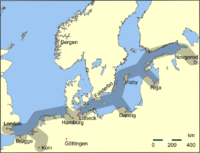
Saxon Quarter Baltic Quarter Breslau (Wrocław) · Dorpat (Tartu) · Elbing (Elbląg) · Königsberg (Kaliningrad) · Kraków · Reval (Tallinn) · Rīga · Thorn (Toruń)Westphalian
QuarterPrincipal Kontore Subsidiary Kontore Other cities Capital cities of the Member States of the European Union 
European Capitals of Culture 1985 Athens · 1986 Florence · 1987 Amsterdam · 1988 West Berlin · 1989 Paris · 1990 Glasgow · 1991 Dublin · 1992 Madrid · 1993 Antwerp · 1994 Lisbon · 1995 Luxembourg City · 1996 Copenhagen · 1997 Thessaloniki · London 1998 Stockholm · 1999 Weimar · 2000 Reykjavík · Bergen · Helsinki · Brussels · Prague · Kraków · Santiago de Compostela · Avignon · Bologna · 2001 Rotterdam · Porto · 2002 Bruges · Salamanca · 2003 Graz · 2004 Genoa · Lille · 2005 Cork · 2006 Patras · 2007 Luxembourg City and Greater Region · Sibiu · 2008 Liverpool · Stavanger · 2009 Linz · Vilnius · 2010 Essen · Istanbul · Pécs · 2011 Turku · Tallinn · 2012 Maribor · Guimarães · 2013 Košice · Marseille · 2014 Umeå · Riga · 2015 Mons · Plzeň · 2016 San Sebastián · Wrocław
Host cities of the Eurovision Song Contest 1950s 1960s 1970s 1980s The Hague · Dublin · Harrogate · Munich · Luxembourg · Gothenburg · Bergen · Brussels · Dublin · Lausanne1990s 2000s 2010s World Heritage Sites in Estonia Historic Centre (Old Town) of Tallinn · Struve Geodetic Arc (with nine other countries)
Tallinn landmarks Buildings and structures Toompea Castle · Tallinn Town Hall · Old Thomas · Linnahall · Kiek in de Kök · St Mary's Cathedral · St. Olaf's church · St. Nicholas' Church · Alexander Nevsky Cathedral · Town Hall Pharmacy · Pikk Hermann tower · Pirita Monastery · Kadriorg Palace · TV Tower · Independence War Victory Column · Bronze Soldier · Russalka MemorialPrecincts Nature and parks Cultural institutions Estonia Theatre · Museum of Art · Tallinn Zoo · Song Festival Grounds · Estonian Open Air Museum (Kolu kõrts) · Estonian Maritime MuseumSports Pirita Yachting Centre · A. Le Coq Arena · Saku Suurhall Arena · Kalevi Keskstaadion · Kadriorg StadiumTransportation Tallinn Passenger Port · Port of Tallinn · Lennart Meri Tallinn Airport · Copterline · Railway station · Elektriraudtee · Edelaraudtee · Go Rail · Bus · Muuga Cargo PortCategories:- World Heritage Sites in Estonia
- Tallinn
- Port cities and towns of the Baltic Sea
- Capitals in Europe
- Members of the Hanseatic League
- Cities and towns in Estonia
- European Capitals of Culture
Wikimedia Foundation. 2010.

